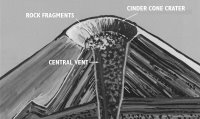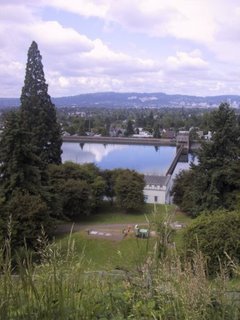Mt. Tabor is a cinder cone volcano, which means its cone-like shape was formed when bits of congealed lava were ejected from a single vent. As the gas-charged lava was blown violently into the air, it broke into small fragments that solidified, forming cinders which fell back down around the vent to create a circular or oval cone. Although the park originated in 1909, the volcanic significance of Mt. Tabor was discovered in 1912. Sometime after that, a small section of the cone was excavated and now you can see its inside wall. Cool!
 I didn’t have a camera with me, so I’m going to use this United States Geoogical Survey graphic to help you visualize the excavated cinder cone wall and its present surroundings. Picture yourself standing in the crater typically found at the top of cinder cone volcanoes. The parking lot was probably built on a portion of the crater. Facing left, you follow a sidewalk which descends from the parking lot down to a basketball court and a small amphitheater constructed at the base of the excavated cinder cone wall. Viewed from down here, the wall looks like a steep drop-off with an irregular surface. Although you can’t really get close enough to touch it, loose bits of cinders lie next to the sidewalk giving you lots of opportunities to feel the volcanic cinder. Interestingly enough, cinder from the excavation was used to pave the basketball court and the parking lot. After a look around, you walk back up to the parking lot. Facing right you see a high mound which constitutes the majority of the park. It’s covered with grass, trees, and shrubs through which trails and a single-lane road meander to the top. If you didn’t know Mt. Tabor was an altered volcano, you would think you were looking at two mountain peaks with a parking lot built in the saddle that separates them. Since the park does not have plaques or signs to explain the topography, that was exactly what I thought. Only when I combed the internet later did I realize that the two mounds of differing heights are actually one volcano – the taller mound representing the bulk of the volcano still intact, the shorter mound representing only a small section of the volcano’s cone, and the parking lot sitting where the crater in the middle would have been.
I didn’t have a camera with me, so I’m going to use this United States Geoogical Survey graphic to help you visualize the excavated cinder cone wall and its present surroundings. Picture yourself standing in the crater typically found at the top of cinder cone volcanoes. The parking lot was probably built on a portion of the crater. Facing left, you follow a sidewalk which descends from the parking lot down to a basketball court and a small amphitheater constructed at the base of the excavated cinder cone wall. Viewed from down here, the wall looks like a steep drop-off with an irregular surface. Although you can’t really get close enough to touch it, loose bits of cinders lie next to the sidewalk giving you lots of opportunities to feel the volcanic cinder. Interestingly enough, cinder from the excavation was used to pave the basketball court and the parking lot. After a look around, you walk back up to the parking lot. Facing right you see a high mound which constitutes the majority of the park. It’s covered with grass, trees, and shrubs through which trails and a single-lane road meander to the top. If you didn’t know Mt. Tabor was an altered volcano, you would think you were looking at two mountain peaks with a parking lot built in the saddle that separates them. Since the park does not have plaques or signs to explain the topography, that was exactly what I thought. Only when I combed the internet later did I realize that the two mounds of differing heights are actually one volcano – the taller mound representing the bulk of the volcano still intact, the shorter mound representing only a small section of the volcano’s cone, and the parking lot sitting where the crater in the middle would have been.Phew! That was a bit tedius – are you still with me? I see what they mean when they say a picture is worth a thousand words.
Getting back to my Mt. Tabor adventure, from the parking lot I hiked to the highest point in the park: elevation 641 feet. Since the height of cinder cone volcanoes is estimated to be 300-500 meters (984-1640 feet), we can assume that lots of erosion has taken place in the last 300,000 years. After all, cinder cone volcanoes aren’t formed of solid rock so they erode more rapidly than other types of volcanoes or regular mountains.
 |
| Photo by Linda Mason Hood |
When my ears started hurting from the cold wind, I went back to the car and drove all around the park’s roads. To the west I had wonderful views of the six reservoirs at the base of the mountain and downtown Portland in the distance. Here is one of those views.
To the east was a view of Mt. Hood and another peak in the Cascade range which I took to be Mt. Adams. Mt. Hood looks wonderful now, by the way, and quite different from the pictures in my October 22 post which were taken at the beginning of October. Now that it’s November Mt. Hood is completely white, and on this day it was gleaming impressively against the blue sky.
Actually, this was an unusually nice fall day, even if it was brutally cold. The incessant rains and thick cloud cover had given way to a sky that was clear blue for the entire day, and Portlanders were lovin’ every minute of it. Despite the brisk wind and freezing temperatures, people were hiking, cycling, and walking their dogs in the park. Young kids scrambled around on the playground equipment and older kids played basketball. Outside the park, local shops were doing a brisk business. In residential neighborhoods, cats basked on porches in the sun. The sight that took the prize, though, was what I saw when I looked out the window of the lovely upper-middle class suburban home where I was staying. A man in his terrycloth bathrobe and slippers raised his garage door, put an aluminum yard chair between his two SUVs, and sat down with his cigarette to catch some winter rays. Ah, suburbia – ya gotta love it! Looking back on the entire day, I wouldn’t be a bit surprised if the sight of that man in his bathrobe inspired my escape to Mt. Tabor Park.
© 2006, Linda Mason Hood
Truffles, Turtles & Tunes Copyright Statement





No comments:
Post a Comment